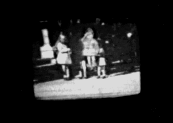|
What Did Jackie Say?
Joseph Wilson
jwilson@world.std.comWhat Did Jackie Say? is an installation that explores the motivation that caused John Kennedy, Jr., to salute the casket at his father's funeral in 1963. The inspiration for this installation came from a conversation I had with one of the journalists who covered the Kennedys before, during and after the assassination. The image of John, Jr., saluting came up during this conversation. The image remained in my memory as American iconography representative of that time. The journalist doubted that the 3-year-old could comprehend such an action or be motivated to do it on his own. The more I thought about the salute, the more I questioned its intent. In the footage of the saluting child, it is obvious that Jackie indeed directed him to do it. What was her motivation in doing this? Did John, Jr., understand the situation at hand? For whom was the salute intended? Outside of the public arena, would the same motivation exist? What did Jackie say? The large-scale installation was first shown at Mobius in Boston, Massachusetts. Throughout the piece I repeat the image of the salute in various forms and media while exaggerating the gesture to be questioned by the viewer. The main structure of the installation is a hallway measuring 27 x 8 x 8 ft constructed with polyvinyl chloride (PVC) pipe and aluminum joints. There is also a 10-ft square "living room" attached to the left side of the main hallway fabricated from the same materials. The entire structure is covered with cotton muslin stretched over the pipe and held in place with Velcro. Eight large, black silhouettes of the saluting image of John, Jr., line both sides of the hallway. Halfway down the left side of the hallway is a glass window frame suspended from the ceiling. The living room can be viewed only through this window. At the end of the hallway are 20 black-and-white and color televisions piled on both sides of another structure suspending two smaller televisions (Fig. 1). As the viewer enters the hallway, a motion detector triggers the play of a sound environment comprised of news reports of the assassination mixed with the sound of a mother's heartbeat recorded through a womb. Details of photographs from the "Camelot" era project along the right wall. Eyes, ears and hands follow each other---stripped of their origins. Through the glass window located in the middle of the left wall is seen a living-room setting, vintage 1963---chair, end tables, and a television with artifacts from this era. I felt that an accurate representation of the setting where most people experienced the funeral was an important element in the piece. A television, the only light source in the room, illuminates newspaper headlines of the assassination laying on the coffee table. Hanging from the ceiling are 100 8-in silhouettes of John, Jr., saluting an image made of black metal screen. They are suspended at different heights and scattered throughout the room. The screens resemble static emanating from the television and floating in the air---intermittently emulating the saluting image. As viewers reach the end of the hallway, their motion triggers the stacks of televisions. I felt that the televisions remaining idle until the viewer reached this point accentuated other parts of the installation. I used televisions that were manufactured in the late 1950s up to the present in order to depict the generations to follow that would experience the event through television. In the middle of the piles of televisions is a structure consisting of a 4-x-2-ft base skirted in white, pleated fabric. Ascending from the base are 17 white columns that arch at opposing 60<198> angles and support two small televisions. Twenty-five pairs of glass eyes partially buried in sand cover the entire surface of the base. Two large line drawings of the saluting child hang on the wall behind the columns. One videotape plays simultaneously on all the televisions and on the television in the living room. The video consists of the 6 seconds of the footage of John, Jr., saluting, which was fed through a computer for effects and animation. Robert Mitchell of PushPlay video graphics collaborated in the creation of the 20- min video and provided production facilities. When exiting the piece, viewers are confronted by a large, white silhouette of the saluting image that has a small monitor embedded in it playing the video. A quote by John Kennedy is written on the silhouette and reads "In serving his vision of truth the artist best serves his nation."
|
___________________________________________________________________________________________________
copyright 1995 ISAST
